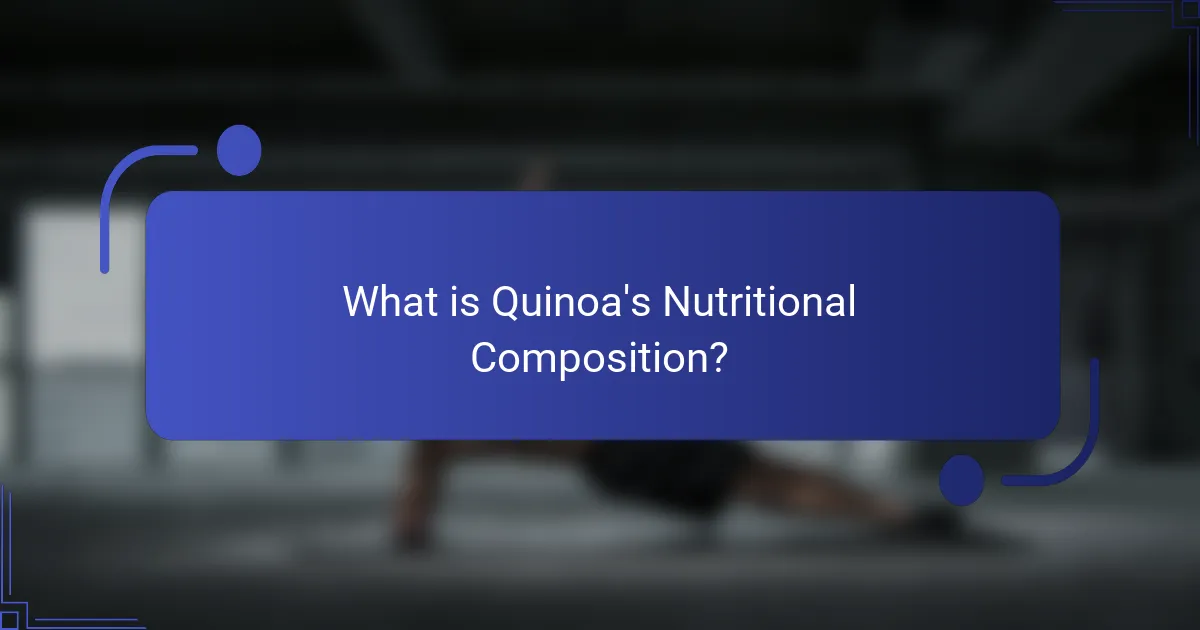Quinoa offers numerous health benefits, including improved heart health and enhanced digestion. This nutrient-dense seed is a complete protein source, rich in essential amino acids. Its culinary versatility allows for easy incorporation into various dishes, making it ideal for holistic diets. Understanding quinoa’s nutritional profile and cooking methods can further enhance its role in balanced nutrition.

What is Quinoa’s Nutritional Composition?
Quinoa is a nutrient-dense seed, rich in protein, fiber, vitamins, and minerals. It contains all nine essential amino acids, making it a complete protein source. Quinoa’s nutritional composition includes approximately 15 grams of protein, 5 grams of fiber, and significant amounts of magnesium, phosphorus, and iron per cooked cup. This unique profile supports muscle health, digestion, and energy levels, making quinoa a versatile ingredient in holistic diets. Its gluten-free nature further enhances its appeal for those with dietary restrictions.
How Does Quinoa Compare to Other Grains in Nutritional Value?
Quinoa offers superior nutritional value compared to many grains, being high in protein and fiber. It contains all nine essential amino acids, making it a complete protein source, unlike most grains. Additionally, quinoa is gluten-free, rich in vitamins and minerals, such as magnesium and iron. Compared to brown rice, quinoa has more protein per serving (8 grams vs. 5 grams) and a lower glycemic index, making it beneficial for blood sugar control. Its versatility in culinary uses allows it to be incorporated into salads, soups, and side dishes, enhancing holistic diets.
Which Vitamins and Minerals are Abundant in Quinoa?
Quinoa is rich in vitamins and minerals, including magnesium, phosphorus, manganese, and folate. These nutrients contribute to its health benefits, supporting bone health, energy production, and overall well-being. Quinoa’s unique profile makes it a valuable addition to holistic diets.

What Are the Health Benefits of Including Quinoa in Your Diet?
Including quinoa in your diet offers numerous health benefits such as improved heart health, enhanced digestion, and better blood sugar control. Quinoa is rich in protein, fiber, and essential nutrients like magnesium and iron. Its unique attribute lies in being a complete protein, containing all nine essential amino acids. Additionally, quinoa has a low glycemic index, making it beneficial for those managing diabetes. Incorporating quinoa into meals can also support weight management due to its high satiety factor.
How Can Quinoa Support Weight Management and Metabolism?
Quinoa can support weight management and metabolism due to its high protein content and low glycemic index. This nutrient-dense grain offers essential amino acids, promoting satiety and reducing overall calorie intake. Additionally, quinoa contains fiber, aiding digestion and stabilizing blood sugar levels. Its unique attribute includes being a complete protein, providing all nine essential amino acids, which is rare among plant foods. Incorporating quinoa into meals can enhance a holistic diet, contributing to sustainable weight management.
Why is Quinoa Considered a Complete Protein Source?
Quinoa is considered a complete protein source because it contains all nine essential amino acids. This unique attribute makes quinoa particularly valuable for vegetarians and vegans seeking high-quality protein. Each cup of cooked quinoa offers approximately 8 grams of protein, contributing significantly to daily nutritional needs. Additionally, quinoa is rich in fiber, vitamins, and minerals, enhancing its overall health benefits. Its versatility in culinary uses allows it to be incorporated into various dishes, making it a preferred choice in holistic diets.
What Role Does Quinoa Play in Reducing Inflammation?
Quinoa plays a significant role in reducing inflammation due to its high content of antioxidants and anti-inflammatory compounds. This ancient grain contains flavonoids, such as quercetin and kaempferol, which help combat oxidative stress. Additionally, quinoa is rich in fiber, promoting gut health, which is linked to lower inflammation levels. Its unique amino acid profile provides essential nutrients that support overall health and may further reduce inflammatory responses in the body.

How Can Quinoa Be Incorporated into Holistic Diets?
Quinoa can be easily incorporated into holistic diets due to its rich nutritional profile and versatility. This ancient grain is high in protein, fiber, and essential amino acids, making it a complete protein source.
Incorporating quinoa into meals can enhance overall health. For instance, it can be used as a base for salads, added to soups, or served as a side dish. Its nutty flavor complements various ingredients, promoting diverse culinary applications.
Quinoa’s unique attribute is its gluten-free nature, making it suitable for individuals with gluten sensitivities. Additionally, its high antioxidant content supports overall wellness, aligning with holistic dietary principles.
As a result, integrating quinoa into daily meals can contribute to balanced nutrition and improved health outcomes.
Which Culinary Techniques Enhance Quinoa’s Flavor and Texture?
To enhance quinoa’s flavor and texture, techniques such as toasting, soaking, and cooking in broth are effective. Toasting quinoa before cooking deepens its nutty flavor. Soaking reduces cooking time and improves digestibility. Cooking in vegetable or chicken broth infuses additional flavor, making quinoa more appealing in dishes.
What Are Popular Quinoa Recipes Across Different Cultures?
Quinoa is a versatile ingredient used in many cultural recipes. Popular quinoa dishes include Peruvian quinoa salad, Indian quinoa biryani, and Middle Eastern quinoa tabbouleh. These recipes highlight quinoa’s nutritional benefits, such as being high in protein and fiber.
Peruvian quinoa salad combines quinoa with fresh vegetables, lime, and herbs, showcasing its unique flavor. Indian quinoa biryani incorporates spices and vegetables, providing a rich culinary experience. Middle Eastern tabbouleh features quinoa instead of bulgur, offering a gluten-free alternative while retaining the dish’s traditional taste.
These recipes reflect quinoa’s adaptability and nutritional profile, making it a staple in holistic diets around the world.
How Does Quinoa Fit into Plant-Based Diets?
Quinoa is an excellent fit for plant-based diets due to its high protein content and essential amino acids. It offers numerous benefits, including improved digestion and heart health. Quinoa is versatile in culinary uses, serving as a base for salads, bowls, or side dishes. Its unique attribute is being a complete protein source, making it a rare find among plant foods.

What Unique Attributes Make Quinoa Stand Out Among Grains?
Quinoa stands out among grains due to its complete protein profile, gluten-free nature, and high nutrient density. It contains all nine essential amino acids, making it a rare plant-based protein source. Additionally, quinoa is rich in fiber, vitamins, and minerals, such as magnesium and iron. Its versatility in culinary uses allows for incorporation into salads, bowls, and baked goods, enhancing holistic diets.
How Does Quinoa’s Gluten-Free Nature Benefit Certain Diets?
Quinoa’s gluten-free nature significantly benefits those with celiac disease or gluten sensitivity. This attribute allows individuals to enjoy a nutritious grain alternative without adverse reactions. Quinoa is rich in protein, fiber, and essential amino acids, making it an excellent choice for holistic diets. As a result, it supports digestive health and provides sustained energy. Additionally, its versatility in culinary uses enhances meal variety while adhering to gluten-free dietary restrictions.
What Are the Environmental Benefits of Quinoa Cultivation?
Quinoa cultivation offers significant environmental benefits, including soil health improvement and reduced water usage. Its deep root system enhances soil structure, preventing erosion and promoting biodiversity. Quinoa requires less water than traditional crops, making it suitable for arid regions. Additionally, it can be grown in diverse climates, contributing to sustainable agriculture practices. These factors position quinoa as a resilient crop that supports ecological balance.

What Are Common Misconceptions About Quinoa?
Common misconceptions about quinoa include its classification as a grain and its protein content. Many believe quinoa is a true grain, but it is actually a seed. Quinoa is often praised for its high protein content, yet it contains about 8 grams of protein per cooked cup, which may not be sufficient as a sole protein source. Additionally, some think quinoa is gluten-free, which is accurate, but cross-contamination can occur during processing. Lastly, the idea that quinoa is unsuitable for weight loss is misleading; its fiber content can aid in satiety and weight management.
Why Do Some People Experience Digestive Issues with Quinoa?
Some people experience digestive issues with quinoa due to its high fiber content and saponins. These compounds can cause bloating, gas, or discomfort in sensitive individuals. Quinoa contains 2.8 grams of fiber per 100 grams, which may be too much for those unaccustomed to high-fiber diets. Additionally, saponins, found on quinoa’s outer layer, can irritate the digestive tract if not rinsed thoroughly before cooking. Proper preparation, such as rinsing and gradual introduction into the diet, can help mitigate these issues.
Which Myths Surround Quinoa’s Nutritional Profile?
Many myths surround quinoa’s nutritional profile, including misconceptions about its protein quality and gluten content. Quinoa is a complete protein, containing all nine essential amino acids, which contradicts the belief that it lacks certain amino acids. Additionally, quinoa is naturally gluten-free, making it suitable for those with gluten intolerance, despite myths suggesting otherwise. Its high fiber content also contributes to digestive health, countering the myth that it may cause digestive issues. Understanding these facts can help integrate quinoa effectively into holistic diets.

What Best Practices Should You Follow When Cooking Quinoa?
To cook quinoa effectively, rinse it, use a 2:1 water-to-quinoa ratio, and simmer for about 15 minutes. This ensures a fluffy texture while retaining its nutritional profile.
1. Rinse quinoa under cold water to remove saponins, which can impart a bitter taste.
2. Combine rinsed quinoa and water in a pot; bring to a boil.
3. Reduce heat, cover, and simmer for 15 minutes until water is absorbed.
4. Let it sit covered for 5 minutes, then fluff with a fork.
Following these steps maximizes quinoa’s health benefits, including its high protein content and essential amino acids.
How Can You Avoid Common Mistakes When Preparing Quinoa?
To avoid common mistakes when preparing quinoa, rinse it thoroughly to remove saponins, which can impart a bitter taste. Use the correct water-to-quinoa ratio, typically two cups of water for one cup of quinoa, to ensure proper cooking. Allow it to simmer gently and avoid overcooking, which can lead to a mushy texture. Lastly, let it rest after cooking to achieve a fluffy consistency.
What Storage Tips Help Maintain Quinoa’s Freshness?
To maintain quinoa’s freshness, store it in an airtight container in a cool, dark place. Avoid moisture and heat exposure, which can lead to spoilage. Quinoa can last up to five years if stored properly. For optimal flavor, consider refrigerating or freezing it.


